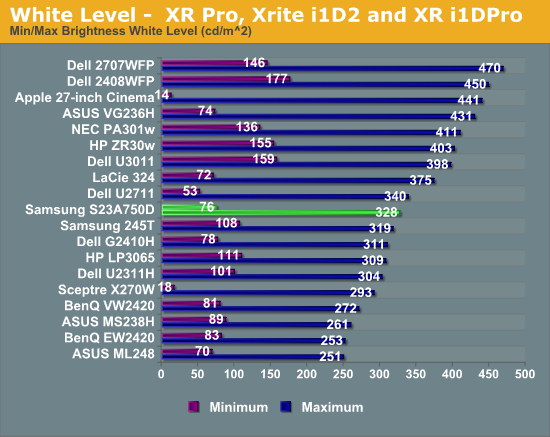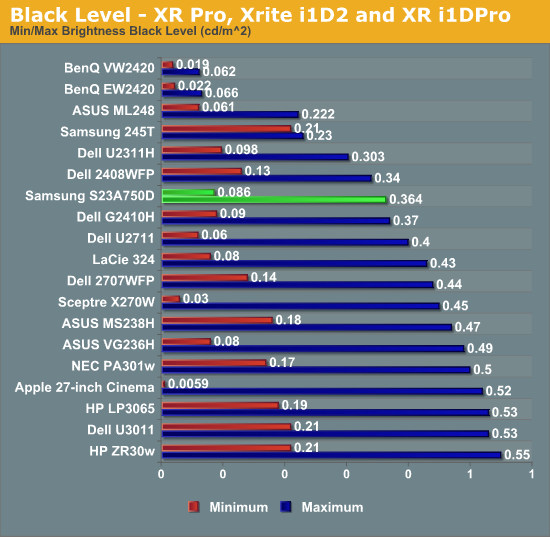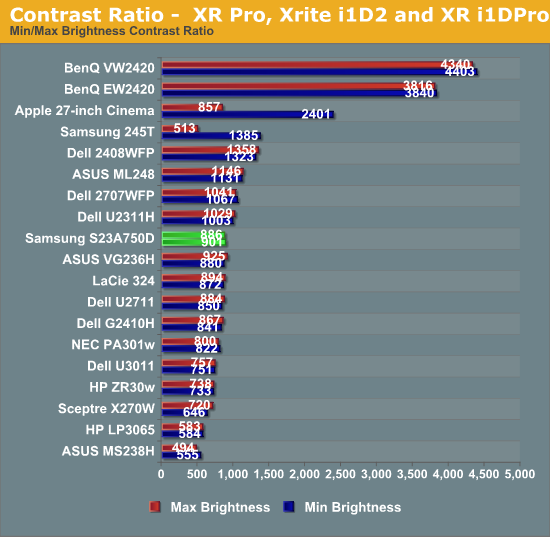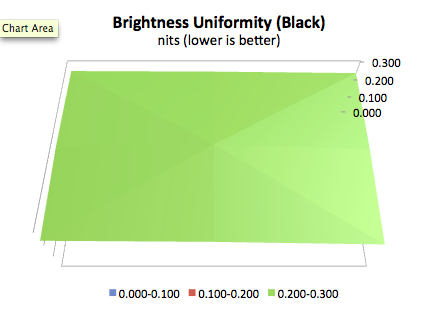Samsung S23A750D 3D LCD Display
by Chris Heinonen on December 17, 2011 2:45 PM ESTSamsung S23A750D Brightness and Contrast
The S23A can produce more light output than many monitors, with over 300 nits of light output possible. While in most cases I would say this kind of light output is a crazy amount that few people will use, the highly glossy screen on the Samsung might make this much light output useful if you have a lot of reflections around your work area from windows or overhead lights. Additionally, Active 3D glasses will cut the light output in more than half, as each eye only views the display half the time and they have tint to them, so ~25% of that light output would be 80 nits. It also manages 76 nits with the backlight brightness set to the minimum, so that gives you a very wide range to adjust the monitor to your preference.

The black output level on the Samsung falls right into the expected range for the monitor. I was a bit disappointed with this as Samsung has managed to get darker blacks out of their LED edgelit TVs, so I was hoping more of that technology would copy over to their monitors. As it is, it’s a little on the bright side for a monitor of this size.

Despite the brighter whites, the black levels rise as well and so the contrast ratios are a pedestrian 900:1 on average. That's neither spectacular nor disappointing; the contrast ratio is merely average for 2011. As usual, we test without dynamic contrast enabled, as the change in backlight intensity tends to be visible and distracting, though Samsung claims up to a 5 million to 1 contrast ratio with dynamic backlighting. (I'm not sure how they'd get there, considering the maximum white level divided by the minimum black level only results in a contrast of 3813:1; they would almost need to shut off the backlight entirely to get down to the necessary 0.000064 nits black level.)

The brightness uniformity of the S23A comes in as merely average as well. With the center at just over 200 nits, only one other area of the screen measured over 190 nits, and only one more was even over 180 nits, with the lower right of the screen measuring over 20% darker than the center.

The black uniformity was a little better, though the higher black level overall meant that none of the values were spectacular. The same lower-right area that was darker in the brightness measurements was also darkest in the black measurements, so the backlight just seems to not be as powerful in that area.











80 Comments
View All Comments
AnnihilatorX - Monday, December 19, 2011 - link
Agreed too.I suppose it's some form of advertising contract with AMD and OCZ acting kind of a sponsor to the site.
Anand Lal Shimpi - Monday, December 19, 2011 - link
We weren't asked to do that by anyone (nor do we allow "advertorial" content on the site - I'll be posting some updated AT guidelines in the not too distant future). From time to time we get updated hardware for our testbeds and we typically call it out in our reviews, the intent here was no different although I do understand that it was interpreted quite differently.Take care,
Anand
Sabresiberian - Monday, December 19, 2011 - link
If you were thrown off by seeing pictures of the PSU, then you weren't reading the article very well. It was obvious to me why Chris might put pictures of the PSU he put in the computer he used to run the video card to run the monitor he was testing. :)I haven't read the whole article, but I suspect some of what is going on here is inflexibility and an inability to read properly. In this day and age, people commonly don't read anything longer than a sentence or two without zoning out.
It's in large part due to a culture in which we have so many distractions (at least in the "western civilized world") that we feel pressed for time, all the time. It's hard to take the time to read an article properly. However, if you are going to read an artivle, I suggest doing it right, and doing it thoroughly, if you really are wasting your time.
;)
Finraziel - Tuesday, December 20, 2011 - link
Agreed, I wasn't bothered by this at all either. The bit about upgrading the GPU and PSU was useful and Chris even specifically states why he included it. It is to stress the fact that if you want to use this monitor for 3D gaming, you are going to need a high power system.About the product, I agree 120hz is very interesting, even more than 3D I think, but it's a shame you have to sacrifice in other areas to get it for now. Hope we soon get 120Hz non-TN panels and some standardisation in 3D gaming.
robinthakur - Monday, December 19, 2011 - link
I found it a tad odd that the person reviewing the display wasn't initially using it with a system which would show it at its best and needed to upgrade their pc on the fly, which could introduce additional bugs.I also take issue with the following bit:
"Since LCD phosphors don’t turn on and off instantly but have a bit of decay time"
This is not a correct explanation of why motion can blur and 3d images can ghost on an LCD screen, more likely a plasma display if we're talking about phosphors and decay-time!
Thanks for the review though, and I'm sure everybody takes time to settle into a role.
Sabresiberian - Monday, December 19, 2011 - link
I think it is informative enough to the people who haven't gone through the procedure, who don't understand what running at 120Hz requires, that the information be included. It's not like he did an in-depth review of the PSU, he just devoted a couple of brief paragraphs with pictures in between.As far as quality - Anandtech has added more editors, and they don't all have the same style as Anand. They shouldn't; they should write in their own style. I suggest you develop a broader mind. I'm not saying there aren't mistakes in grammar and sloppiness, but I do think this "going down hill" business is stating the situation too strongly.
;)
Anand Lal Shimpi - Monday, December 19, 2011 - link
Thanks for your feedback (as well as everyone else in the thread). AMD and OCZ provided the hardware to augment Chris' testbed for the review and I asked him to include his thoughts on the upgrade experience here to hopefully provide more of the end-user side of things. It was a one-time thing that won't be repeated in future reviews, just sort of a stake in the ground indicating a change to the standard display reviews testbed.I do hear you loud and clear though and it's not hard for us to change the way we report changes like that in the future. I've added a section header to the GPU + PSU changes to hopefully explain the intention of that section a bit better.
Take care,
Anand
PubFiction - Monday, December 19, 2011 - link
I agree,My interpretation was that this was a shameless way to slip in a plug for OCZ and AMD. And while that may not be the case it is important to think about how different people will interpret an action.
"Since LCD phosphors don’t turn on and off instantly but have a bit of decay time"
Also this one quote jumped out at me. This is an LCD with LED backligting. It does not have any phosphors because it does not have a fluorescent backlight and on top of that even if it did there would be no fade away. Typically LCD backlights are just ON and the pixels just hold until they switch to a new orientation.
Also I do not get the point in sending a light to non gamer to review a monitor with 120hz gaming and 3D gaming as it's major function.
crimson117 - Monday, December 19, 2011 - link
And then he only tests half life 2 and wow...Sabresiberian - Monday, December 19, 2011 - link
Actually, I thought that Chris presented himself early on as someone who wasn't an "authority", but was putting himself in the role of an average Joe User adopting his setup to a 120Hz monitor for the first time, and describing what the experience was like from that viewpoint. Not everything has to be written like a technical brief presentation or be a class on the electronics of how TN panels work.;)